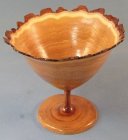Hi All,
I know everyone hates sanding ...
I am looking for suggestions on how to sand the inside of a natural edge bowl. I've watched lots of videos on turning natural edge bowls but they never go into how to sand them.
TIA for your help.
I know everyone hates sanding ...
I am looking for suggestions on how to sand the inside of a natural edge bowl. I've watched lots of videos on turning natural edge bowls but they never go into how to sand them.
TIA for your help.


